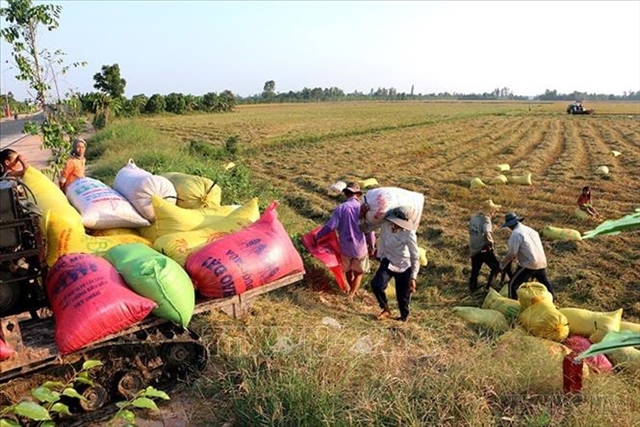 Economy
Economy


|
| Farmers during rice harvest season in the Mekong Delta. VNA/VNS Photo |
HÀ NỘI Vietnamese rice continues to do well on the international markets, fetching both significantly higher prices and a larger number of orders in the first quarter of 2023, according to the Department of Import/Export under the Ministry of Industry and Trade (MoIT).
Việt Nam exported more than 1.85 million tonnes of rice, worth nearly US$1 billion, during the first quarter of the year, a 23 per cent increase in volume and a 34 per cent increase in value compared to the same period last year, according to Trần Quốc Toàn, the department's deputy director.
A tonne of Vietnamese rice fetched $529 on the international markets, up nearly 9 per cent compared to the same period in 2022. During the first quarter of 2023, the country also overtook Thailand and India in 5 per cent broken rice volume to become the world's top rice exporter.
Việt Nam's growth in rice exports has largely contributed to growing market share in major markets such as the European Union (EU), with the country's main products being high-quality fragrant rice and rice-based products.
It showcased the improved quality of Vietnamese rice and the efforts made by local producers to meet stricter and higher safety and environmental standards set by developed markets around the world, according to the MoIT.
In addition, in recent years, the country has been expanding its product portfolio, introducing additional offerings such as glutinous rice, white rice, organic rice and rice with enhanced nutritional value.
Việt Nam has actively sought to reduce the proportion of low-quality rice products for export in recent years.
Nguyễn Ngọc Nam, chairman of the Vietnam Food Association, said a major factor that helped Vietnamese rice during the period was countries worldwide trying to raise their food stockpile.
Demand of traditional major markets like China and the Philippines stayed strong while there has been a surge in other markets, including the EU, Indonesia and Bangladesh. The EU alone imported 50 per cent more rice from Việt Nam compared to the same period last year.
Meanwhile, India and Pakistan continued to enforce rice export quotas. Thai rice has become more expensive due to the appreciation of the Thai baht. Việt Nam, therefore, will likely continue to enjoy both quantity and price advantages over competitors, at least for the near future.
"Overall, in terms of the rice export market this year, the supply is lower than the demand, so the outlook is favourable. Our challenge this year is supplying rice varieties suitable for market demand," Nam added.
Deputy Minister of Industry and Trade Nguyễn Sinh Nhật Tân said while demand has been high, it's still important that producers observe strictly the standards set by the international markets.
He said his ministry has been working closely with the Ministry of Agriculture and Rural Development (MARD) to lay the groundwork for Việt Nam's rice production and export strategy until 2030.
He urged producers and exporters to take full advantage of major free trade agreements Việt Nam has ratified, including the Comprehensive and Progressive Agreement for Trans-Pacific Partnership (CPTPP), the EU - Vietnam FTA (EVFTA), and the UK - Vietnam FTA (UKVFTA),. VNS




